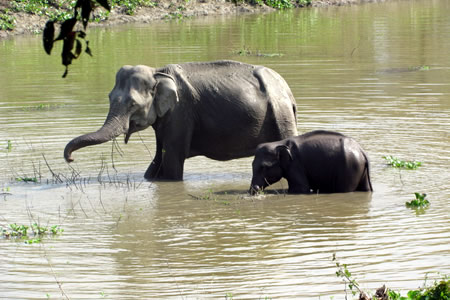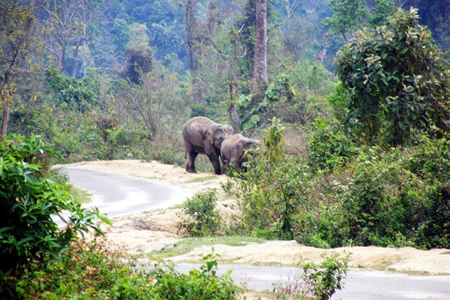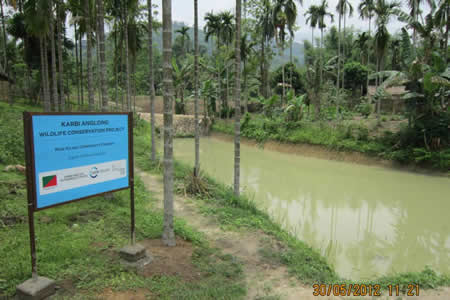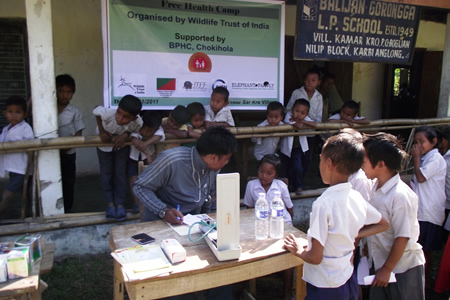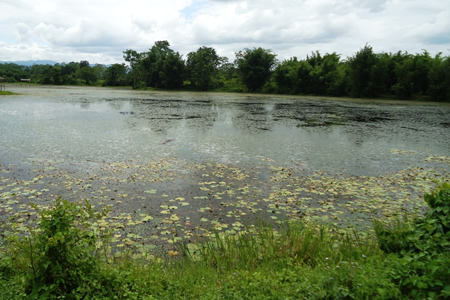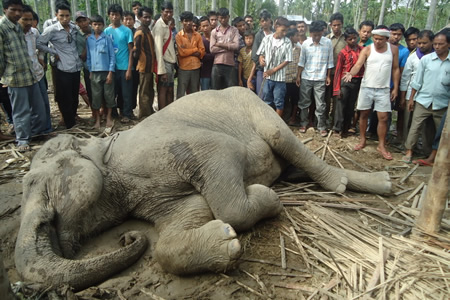Securing the Kalapahar Daigurung elephant corridor
File photo: Asian elephant
Silonijan (Karbi Anglong), September 13, 2012: One-fifth of India’s elephants live in the north-eastern state of Assam. The Kaziranga – Karbi Anglong Elephant Reserve in Central Assam is one of the state’s five elephant reserves and a high priority area for Asian elephant conservation.
The combined Kaziranga – Karbi Anglong Elephant Reserve harbours a large and viable, yet threatened population of about 2000 elephants. These forests are also inhabited by rare and endangered species like the Bengal tiger, clouded leopard, serow, hoolock gibbon and many more.
Increasing demand of land rights for rubber and tea plantation and unsustainable extraction of forest resources over the years is resulting in habitat fragmentation in the autonomous district of Karbi Anglong, the largest district of the state with nearly 10,434 square kms of area. Adding to this is an expanding human population that is one of the major causes of human-elephant conflict in this region, which results in the death and injury of a number of people and elephants each year in the district. The most important conservation priorities for wild elephants would be the conservation of elephant habitat and creating corridors joining fragmented areas.
One such corridor that connects Kaziranga to Karbi Anglong is the Kalapahar – Daigurung elephant corridor located at Silonijan in Karbi Anglong. This is one of the few vital corridors that need to be urgently secured to provide habitat contiguity to the elephants, to prevent these populations from being permanently isolated.
File photo: Asian elephants in Kalapahar – Daigurung
The Wildlife Trust of India (WTI), working in association with the Karbi Anglong Autonomous Council (KAAC) with support from Japan Tiger and Elephant Fund (JTEF), International Union for Conservation of Nature – Netherlands (IUCN- NL), Elephant Family (EF) and local communities is working to secure the Kalapahar – Daigurung elephant corridor to establish a connection in between two important fragmented elephant habitats.
The aim is to acquire the land of Ram Terang Village comprising 19 families (102 people) who are presently dwelling in the middle of the corridor and relocating them away from the corridor. The secured corridor would be subsequently declared as a Community Conserved Area (CCA).
If this is done, the corridor will connect Kalapahar with Daigurung and Nambor wildlife sanctuary. Elephants use this corridor to move from Nambor- Daigrung WLS to Kaziranga via Bijuli Reserve Forest which further connects to Bokial, Behora and Kaziranga.
Community fishery in Ram Kiling
“The connectivity between Kaziranga and Karbi Anglong landscapes will be improved through the acquisition of Kalapahar – Daigurung corridor and we are working on a concrete plan to relocate and rehabilitate the residents of the corridor area,” said Dilip Deori, Assistant Manager, WTI, who is working with the communities to secure the elephant corridors of Karbi Anglong. “Land securement would not be successful without the participation of local communities, for which we are working on various confidence building activities among the people,” he added.
Eco development support is one such confidence-building activity that has already been initiated in the villages close to the corridor. Handloom kits were distributed among the people and Community fisheries were developed. Piglets were also distributed to people of the participating villages. Alternative livelihoods will help boost the income of the villagers and further reduce their dependency on the forest.
Health camp
WTI has also conducted several trainings on livestock and animal husbandry for the community, are empowering women with training and development and are helping people with loans to develop small scale and cottage industries in the village.
“We have been conducting regular awareness programmes to sensitise the villagers on conservation,” said Borsali Teron, Field Officer, WTI who is helping to implement the project at the grassroots through green livelihoods, basic amenities like free healthcare, safe drinking water and educational support to the villagers.
At a recent health camp organised by WTI with support of National Rural Health Mission (NRHM), JTEF, IUCN and KAAC, more than 86 patients were given a health check-up and free medicine at Balijan Gorungga LP School of Sar Kro village recently. Villagers from villages from the corridor area – Ram Kiling, Sar Kro and Ram Terang participated in the health camp.
In a new initiative for preserving a wet land connecting the Kalapahar – Daigurung corridor, a lake named “Ching Hon” which is being used by elephants, will soon be declared as a Community Conserved Area (CCA) through a Rapid Action Project (RAP) sanctioned by WTI to clean and conserve it.
File photo: Chinghon lake
WTI’s Karbi Anglong Conservation Project is also addressing human- elephant conflict in the district through installation of electric fence and ex gratia to victims of elephant conflict. The MVS (Mobile veterinary Service) of WTI equipped with a wildlife veterinarian, a keeper and necessary medical supplies also is an important constituent of the Karbi Anglong Conservation Project that attends to cases of injured elephants throughout the district.
“Recently a female elephant died of electrocution as a retaliatory measure by people at Nahorsala village in Silonijan range of Karbi Anglong, close to the Kalapahar-Doigrung elephant corridor,” said Dr Anthony Nokso Phangcho, veterinarian with WTI’s Karbi Anglong Conservation Project. “With the rice harvesting season approaching chances of conflict are very likely and we are on high alert,” he added.
Four people have lost their lives due to human-elephant conflicts in the Choukihola area near the corridor, between 2010 and 2012.
File photo: Elephant killed due to conflict

